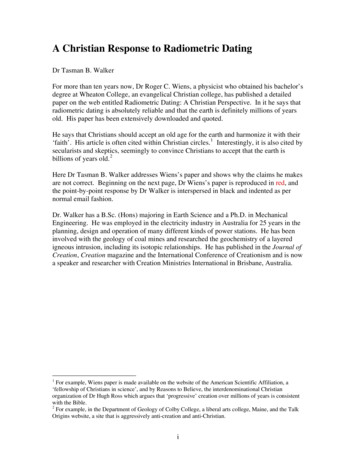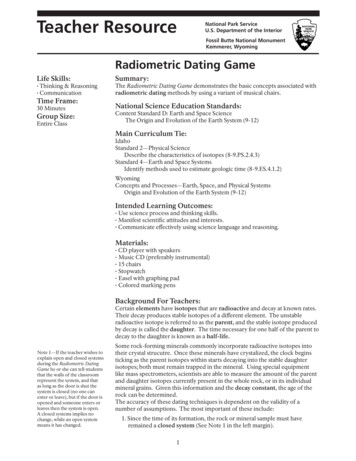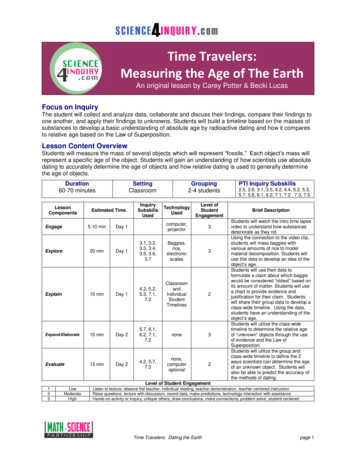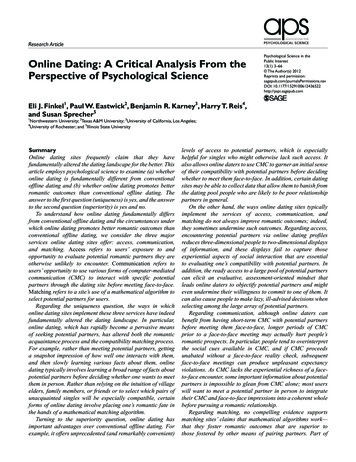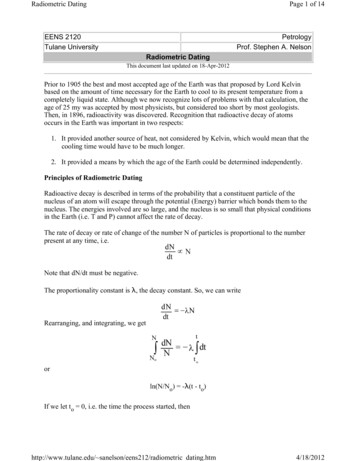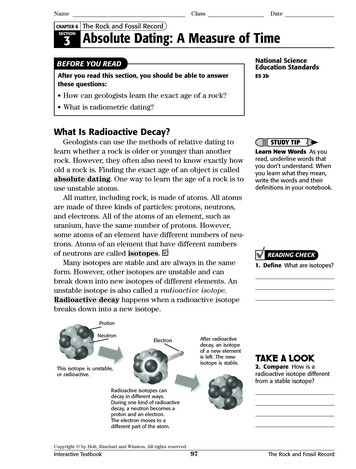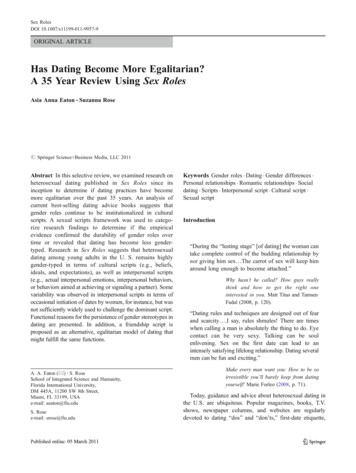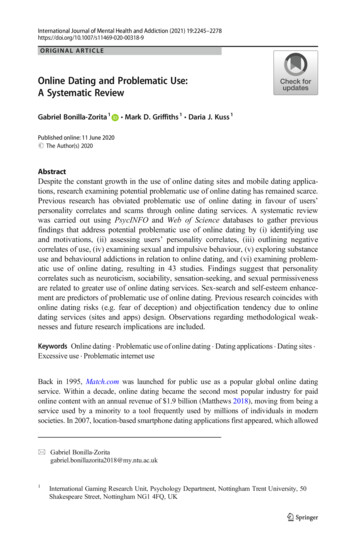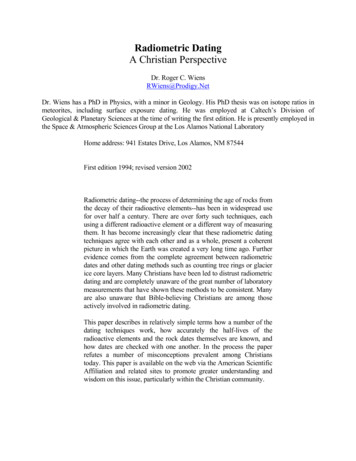
Transcription
Radiometric DatingA Christian PerspectiveDr. Roger C. WiensRWiens@Prodigy.NetDr. Wiens has a PhD in Physics, with a minor in Geology. His PhD thesis was on isotope ratios inmeteorites, including surface exposure dating. He was employed at Caltech’s Division ofGeological & Planetary Sciences at the time of writing the first edition. He is presently employed inthe Space & Atmospheric Sciences Group at the Los Alamos National LaboratoryHome address: 941 Estates Drive, Los Alamos, NM 87544First edition 1994; revised version 2002Radiometric dating--the process of determining the age of rocks fromthe decay of their radioactive elements--has been in widespread usefor over half a century. There are over forty such techniques, eachusing a different radioactive element or a different way of measuringthem. It has become increasingly clear that these radiometric datingtechniques agree with each other and as a whole, present a coherentpicture in which the Earth was created a very long time ago. Furtherevidence comes from the complete agreement between radiometricdates and other dating methods such as counting tree rings or glacierice core layers. Many Christians have been led to distrust radiometricdating and are completely unaware of the great number of laboratorymeasurements that have shown these methods to be consistent. Manyare also unaware that Bible-believing Christians are among thoseactively involved in radiometric dating.This paper describes in relatively simple terms how a number of thedating techniques work, how accurately the half-lives of theradioactive elements and the rock dates themselves are known, andhow dates are checked with one another. In the process the paperrefutes a number of misconceptions prevalent among Christianstoday. This paper is available on the web via the American ScientificAffiliation and related sites to promote greater understanding andwisdom on this issue, particularly within the Christian community.
Radiometric DatingA Christian PerspectiveDr. Roger C. WiensTABLE OF CONTENTSIntroduction.1Overview.1The Radiometric Clocks.3Examples of Dating Methods for Igneous Rocks .4Potassium-Argon ium, Lutetium-Hafnium, and Rhenium-Osmium.9Uranium-Lead.9The Age of the Earth .10Extinct Radionuclides: The Hourglasses that Ran Out .11Cosmogenic Radionuclides: Carbon-14, Beryllium-10, Chlorine-36 .12Radiometric Dating of Geologically Young Samples .15Non-Radiogenic Dating Methods for the Past 100,000 Years.16Ice Cores.16Varves .17Other Annual-Layering Methods.18Thermoluminescence.18Electron Spin Resonance.18Cosmic Ray Exposure Dating.18Can We Really Believe the Dating Systems? .19Doubters Still Try.20Apparent Age?.21Rightly Handling the Word of Truth .22Appendix: Common Misconceptions Regarding Radiometric Dating Techniques.23Resources on the Web.28Further Reading: Books .29Acknowledgements .31More About the Author.31Glossary .32ii
IntroductionArguments over the age of the Earth have sometimes been divisive for people who regard the Bible asGod’s word. Even though the Earth's age is never mentioned in the Bible, it is an issue because those whotake a strictly literal view of the early chapters of Genesis can calculate an approximate date for thecreation by adding up the life-spans of the people mentioned in the genealogies. Assuming a strictly literalinterpretation of the week of creation, even if some of the generations were left out of the genealogies, theEarth would be less than ten thousand years old. Radiometric dating techniques indicate that the Earth isthousands of times older than that--approximately four and a half billion years old. Many Christiansaccept this and interpret the Genesis account in less scientifically literal ways. However, some Christianssuggest that the geologic dating techniques are unreliable, that they are wrongly interpreted, or that theyare confusing at best. Unfortunately, much of the literature available to Christians has been eitherinaccurate or difficult to understand, so that confusion over dating techniques continues.The next few pages cover a broad overview of radiometric dating techniques, show a few examples, anddiscuss the degree to which the various dating systems agree with each other. The goal is to promotegreater understanding on this issue, particularly for the Christian community. Many people have been ledto be skeptical of dating without knowing much about it. For example, most people don't realize thatcarbon dating is only rarely used on rocks. God has called us to be "wise as serpents" (Matt. 10:16) evenin this scientific age. In spite of this, differences still occur within the church. A disagreement over the ageof the Earth is relatively minor in the whole scope of Christianity; it is more important to agree on theRock of Ages than on the age of rocks. But because God has also called us to wisdom, this issue is worthyof study.OverviewRocks are made up of many individual crystals, and each crystal is usuallymade up of at least several different chemical elements such as iron,magnesium, silicon, etc. Most of the elements in nature are stable and do notchange. However, some elements are not completely stable in their naturalstate. Some of the atoms eventually change from one element to another by aprocess called radioactive decay. If there are a lot of atoms of the originalelement, called the parent element, the atoms decay to another element, calledthe daughter element, at a predictable rate. The passage of time can be chartedby the reduction in the number of parent atoms, and the increase in thenumber of daughter atoms.Radiometric dating can be compared to an hourglass. When the glass is turnedover, sand runs from the top to the bottom. Radioactive atoms are likeindividual grains of sand—radioactive decays are like the falling of grainsfrom the top to the bottom of the glass. You cannot predict exactly when any one particular grain will getto the bottom, but you can predict from one time to the next how long the whole pile of sand takes to fall.Once all of the sand has fallen out of the top, the hourglass will no longer keep time unless it is turnedover again. Similarly, when all the atoms of the radioactive element are gone, the rock will no longer keeptime (unless it receives a new batch of radioactive atoms).1
Unlike the hourglass, where the amount ofsand falling is constant right up until the end,the number of decays from a fixed number ofradioactive atoms decreases as there arefewer atoms left to decay (see Figure 1). If ittakes a certain length of time for half of theatoms to decay, it will take the same amountof time for half of the remaining atoms, or afourth of the original total, to decay. In thenext interval, with only a fourth remaining,only one eighth of the original total willdecay. By the time ten of these intervals, orhalf-lives, has passed, less than onethousandth of the original number ofradioactive atoms is left. The equation for thefraction of parent atoms left is very simple.The type of equation is exponential, and isrelated to equations describing other wellknown phenomena such as populationgrowth. No deviations have yet been foundfrom this equation for radioactive decay.Also unlike the hourglass, there is no way tochange the rate at which radioactive atomsdecay in rocks. If you shake the hourglass,twirl it, or put it in a rapidly acceleratingvehicle, the time it takes the sand to fall willchange. But the radioactive atoms used indating techniques have been subjected toheat, cold, pressure, vacuum, acceleration,and strong chemical reactions to the extentthat would be experienced by rocks ormagma in the mantle, crust, or surface of theEarth or other planets without any significantchange in their decay rate.1Figure 1. The rate of loss of sand from the top of an hourglasscompared to the exponential type of decay of radioactive elements.Most processes we are familiar with are linear, like sand in thehourglass. In exponential decay the amount of material decreases byhalf during each half-life. After two half-lives only one fourth is left,after three half-lives only an eighth is left, etc. As shown in thebottom panel, the daughter element or isotope amount increasesrapidly at first and more slowly with each succeeding half-life.An hourglass will tell time correctly only if itis completely sealed. If it has a hole allowing the sand grains to escape out the side instead of goingthrough the neck, it will give the wrong time interval. Similarly, a rock that is to be dated must be sealedagainst loss or addition of either the radioactive daughter or parent. If it has lost some of the daughterelement, it will give an inaccurately young age. As will be discussed later, most dating techniques havevery good ways of telling if such a loss has occurred, in which case the date is thrown out (and so is therock!).1In only a couple of special cases have any decay rates been observed to vary, and none of thesespecial cases apply to the dating of rocks as discussed here. These exceptions are discussed later.2
An hourglass measures how much time has passed since it was turned over. (Actually it tells when aspecific amount of time, e.g., 2 minutes, an hour, etc., has passed, so the analogy is not quite perfect.)Radiometric dating of rocks also tells how much time has passed since some event occurred. For igneousrocks the event is usually its cooling and hardening from magma or lava. For some other materials, theevent is the end of a metamorphic heating event (in which the rock gets baked underground at generallyover a thousand degrees Fahrenheit), the uncovering of a surface by the scraping action of a glacier, thechipping of a meteorite off of an asteroid, or the length of time a plant or animal has been dead.The Radiometric ClocksThere are now well over fortydifferentradiometricdatingtechniques, each based on adifferent radioactive isotope.2 Apartial list of the parent anddaughter isotopes and the decayhalf-lives is given in Table I.Notice the large range in the halflives. Isotopes with long half-livesdecay very slowly, and so areuseful for dating correspondinglyancient events. Isotopes withshorter half-lives cannot date veryancient events because all of theatoms of the parent isotope wouldhave already decayed away, likean hourglass left sitting with allthe sand at the bottom. Isotopeswith relatively short half-lives areuseful for dating correspondinglyshorter intervals, and can usuallydo so with greater accuracy, justas you would use a stopwatchrather than a grandfather clock totime a 100 meter dash. On theother hand, you would use acalendar, not a clock, to recordtime intervals of several weeks ormore.Table I Some Naturally-Occurring Radioactive Isotopes andTheir Half-LivesRadioactive marium-147Neodymium-143106 billionRubidium-87Strontium-8748.8 billionRhenium-187Osmium-18742 billionLutetium-176Hafnium-17638 billionThorium-232Lead-20814 billionUranium-238Lead-2064.5 billionPotassium-40Argon-401.26 billionUranium-235Lead-2070.7 billionBeryllium-10Boron-101.52 ium-22675,400Most half-lives taken from Holden, N.E. (1990) Pure Appl.Chem. 62, 941-958.The half-lives have all been measured directly either by using a radiation detector to count the number ofatoms decaying in a given amount of time from a known amount of the parent material, or by measuring2The term isotope subdivides elements into groups of atoms that have the same atomic weight.For example carbon has isotopes of weight 12, 13, and 14 times the mass of a nucleon, referred to ascarbon-12, carbon-13, or carbon-14 (abbreviated as 12C, 13C, 14C). It is only the carbon-14 isotopethat is radioactive. This will be discussed further in a later section.3
the ratio of daughter to parent atoms in a sample that originally consisted completely of parent atoms.Work on radiometric dating first started shortly after the turn of the 20th century, but progress wasrelatively slow before the late forties. However, by now we have had over fifty years to measure and remeasure the half-lives for many of the dating techniques. Very precise counting of the decay events or thedaughter atoms can be done, so while the number of, say, rhenium-187 atoms decaying in 50 years is avery small fraction of the total, the resulting osmium-187 atoms can be very precisely counted. Forexample, recall that only one gram of material contains over 1021 (1 with 21 zeros behind) atoms. Evenif only one trillionth of the atoms decay in one year, this is still millions of decays, each of which canbe counted by a radiation detector!The uncertainties on the half-lives given in the table are all very small. All of the half-lives are known tobetter than about two percent except for rhenium (5%), lutetium (3%), and beryllium (3%). There is noevidence of any of the half-lives changing over time. In fact, as discussed below, they have been observedto not change at all over hundreds of thousands of years.Examples of Dating Methods for Igneous RocksNow let's look at how the actual dating methods work. Igneous rocks are good candidates for dating.Recall that for igneous rocks the event being dated is when the rock was formed from magma or lava.When the molten material cools and hardens, the atoms are no longer free to move about. Daughter atomsthat result from radioactive decays occurring after the rock cools are frozen in the place where they weremade within the rock. These atoms are like the sand grains accumulating in the bottom of the hourglass.Determining the age of a rock is a two-step process. First one needs to measure the number of daughteratoms and the number of remaining parent atoms and calculate the ratio between them. Then the half-lifeis used to calculate the time it took to produce that ratio of parent atoms to daughter atoms.However, there is one complication. One cannot always assume that there were no daughter atoms tobegin with. It turns out that there are some cases where one can make that assumption quite reliably. Butin most cases the initial amount of the daughter product must be accurately determined. Most of the timeone can use the different amounts of parent and daughter present in different minerals within the rock totell how much daughter was originally present. Each dating mechanism deals with this problem in its ownway. Some types of dating work better in some rocks; others are better in other rocks, depending on therock composition and its age. Let's examine some of the different dating mechanisms now.Potassium-Argon. Potassium is an abundant element in the Earth's crust. One isotope, potassium-40, isradioactive and decays to two different daughter products, calcium-40 and argon-40, by two differentdecay methods. This is not a problem because the production ratio of these two daughter products isprecisely known, and is always constant: 11.2% becomes argon-40 and 88.8% becomes calcium-40. It ispossible to date some rocks by the potassium-calcium method, but this is not often done because it is hardto determine how much calcium was initially present. Argon, on the other hand, is a gas. Whenever rock ismelted to become magma or lava, the argon tends to escape. Once the molten material hardens, it beginsto trap the new argon produced since the hardening took place. In this way the potassium-argon clock isclearly reset when an igneous rock is formed.In its simplest form, the geologist simply needs to measure the relative amounts of potassium-40 andargon-40 to date the rock. The age is given by a relatively simple equation:t h x ln[1 (argon-40)/(0.112 x (potassium-40))]/ln(2)where t is the time in years, h is the half-life, also in years, and ln is the natural logarithm.4
However, in reality there is often a small amount of argon remaining in a rock when it hardens. This isusually trapped in the form of very tiny air bubbles in the rock. One percent of the air we breathe is argon.Any extra argon from air bubbles may need to be taken into account if it is significant relative to theamount of radiogenic argon (that is, argon produced by radioactive decays). This would most likely be thecase in either young rocks that have not had time to produce much radiogenic argon, or in rocks that arelow in the parent potassium. One must have a way to determine how much air-argon is in the rock. This israther easily done because air-argon has a couple of other isotopes, the most abundant of which is argon36. The ratio of argon-40 to argon-36 in air is well known, at 295. Thus, if one measures argon-36 as wellas argon-40, one can calculate and subtract off the air-argon-40 to get an accurate age.One of the best ways of showing that an age-date is correct isto confirm it with one or more different dating method(s).Although potassium-argon is one of the simplest datingmethods, there are still some cases where it does not agreewith other methods. When this does happen, it is usuallybecause the gas within bubbles in the rock is from deepunderground rather than from the air. This gas can have ahigher concentration of argon-40 escaping from the meltingof older rocks. This is called parentless argon-40 because itsparent potassium is not in the rock being dated, and is alsonot from the air. In these slightly unusual cases, the dategiven by the normal potassium-argon method is too old.However, scientists in the mid-1960s came up with a wayaround this problem, the argon-argon method, discussed inthe next section.Some young-Earth proponents recentlyreported that rocks were dated by thepotassium-argon method to be a severalmillion years old when they are really only afew years old. But the potassium-argonmethod, with its long half-life, was neverintended to date rocks only 25 years old.These people have only succeeded in correctlyshowing that one can fool a single radiometricdating method when one uses it improperly.The false radiometric ages of several millionyears are due to parentless argon, as describedhere, and first reported in the literature somefifty years ago. Note that it would beextremely unlikely for another dating methodto agree on these bogus ages. Gettingagreement between more than one datingmethod is a recommended practice.Argon-Argon. Even though it has been around for nearlyhalf a century, the argon-argon method is seldom discussed by groups critical of dating methods. Thismethod uses exactly the same parent and daughter isotopes as the potassium-argon method. In effect, it isa different way of telling time from the same clock. Instead of simply comparing the total potassium withthe non-air argon in the rock, this method has a way of telling exactly what and how much argon isdirectly related to the potassium in the rock.In the argon-argon method the rock is placed near the center of a nuclear reactor for a period of hours. Anuclear reactor emits a very large number of neutrons, which are capable of changing a small amount ofthe potassium-39 into argon-39. Argon-39 is not found in nature because it has only a 269-year half-life.(This half-life doesn't affect the argon-argon dating method as long as the measurements are made withinabout five years of the neutron dose). The rock is then heated in a furnace to release both the argon-40 andthe argon-39 (representing the potassium) for analysis. The heating is done at incrementally highertemperatures and at each step the ratio of argon-40 to argon-39 is measured. If the argon-40 is from decayof potassium within the rock, it will come out at the same temperatures as the potassium-derived argon-39and in a constant proportion. On the other hand, if there is some excess argon-40 in the rock it will causea different ratio of argon-40 to argon-39 for some or many of the heating steps, so the different heatingsteps will not agree with each other.5
Figure 2 is an example of a good argonargon date. The fact that this plot is flatshows that essentially all of the argon-40 isfrom decay of potassium within the rock.The potassium-40 content of the sample isfound by multiplying the argon-39 by afactor based on the neutron exposure in thereactor. When this is done, the plateau inthe figure represents an age date based onthe decay of potassium-40 to argon-40.There are occasions when the argon-argondating method does not give an age even ifthere is sufficient potassium in the sampleand the rock was old enough to date. Thismost often occurs if the rock experienced ahigh temperature (usually a thousanddegrees Fahrenheit or more) at some point Figure 2. A typical argon-argon dating plot. Each small rectanglerepresents the apparent age given at one particular heating-stepsince its formation. If that occurs, some of temperature. The top and bottom parts of the rectangles represent upperthe argon gas moves around, and the and lower limits for that particular determination. The age is based on theanalysis does not give a smooth plateau measured argon-40 / argon-39 ratio and the number of neutronsacross the extraction temperature steps. An encountered in the reactor. The horizontal axis gives the amount of the totalexample of an argon-argon analysis that did argon-39 released from the sample. A good argon-argon age determinationnot yield an age date is shown in Figure 3. will have a lot of heating steps which all agree with each other. TheNotice that there is no good plateau in this "plateau age" is the age given by the average of most of the steps, in thiscase nearly 140 million years. After S. Turner et al. (1994) Earth andplot. In some instances there will actually Planetary Science Letters, 121, pp. 333-348.be two plateaus, one representing theformation age, and another representing the time at which the heating episode occurred. But in most caseswhere the system has been disturbed, there simply is no date given. The important point to note is that,rather than giving wrong age dates, this method simply does not give a date if the system has beendisturbed. This is also true of a number of other igneous rock dating methods, as we will describe below.Rubidium-Strontium. In nearly all of the dating methods, except potassium-argon and the associatedargon-argon method, there is always some amount of the daughter product already in the rock when itcools. Using these methods is a little like trying to tell time from an hourglass that was turned over beforeall of the sand had fallen to the bottom. One can think of ways to correct for this in an hourglass: Onecould make a mark on the outside of the glass where the sand level started from and then repeat theinterval with a stopwatch in the other hand to calibrate it. Or if one is clever she or he could examine thehourglass' shape and determine what fraction of all the sand was at the top to start with. By knowing howlong it takes all of the sand to fall, one could determine how long the time interval was. Similarly, thereare good ways to tell quite precisely how much of the daughter product was already in the rock when itcooled and hardened.6
In the rubidium-strontium method, rubidium87 decays with a half-life of 48.8 billion yearsto strontium-87. Strontium has several otherisotopes that are stable and do not decay. Theratio of strontium-87 to one of the other stableisotopes, say strontium-86, increases over timeas more rubidium-87 turns to strontium-87.But when the rock first cools, all parts of therock have the same strontium-87/strontium-86ratio because the isotopes were mixed in themagma. At the same time, some of theminerals in the rock have a higherrubidium/strontiumratiothanothers.Rubidium has a larger atomic diameter thanstrontium, so rubidium does not fit into thecrystal structure of some minerals as well asothers.Figure 4 is an important type of plot used inFigure 3. An argon-argon plot that gives no date. Note that therubidium-strontium dating. It shows the apparent age is different for each temperature step so there is nostrontium-87/strontium-86 ratio on the vertical plateau. This sample was struck with a pressure of 420,000axis and the rubidium-87/strontium-86 ratio on atmospheres to simulate a meteorite impact--an extremely rare eventthe horizontal axis, that is, it plots a ratio of the on Earth. The impact heated the rock and caused its argon to bedaughter isotope against a ratio of the parent rearranged, so it could not give an argon-argon date. Before it wasisotope. At first, all the minerals lie along a smashed the rock gave an age of around 450 million years, as shownthe dotted line. After A. Deutsch and U. Schaerer (1994)horizontal line of constant strontium- byMeteoritics, 29, pp. 301-322.87/strontium-86 ratio but with varyingrubidium/strontium. As the rock starts to age, rubidium gets converted to strontium. The amount ofstrontium added to each mineral is proportional to the amount of rubidium present. This change is shownby the dashed arrows, the lengths of which are proportional to the rubidium/strontium ratio. The dashedarrows are slanted because the rubidium/strontium ratio is decreasing in proportion to the increase instrontium-87/strontium-86. The solid line drawn through the samples will thus progressively rotate fromthe horizontal to steeper and steeper slopes.All lines drawn through the data points at any later time will intersect the horizontal line (constantstrontium-87/strontium-86 ratio) at the same point in the lower left-hand corner. This point, whererubidium-87/strontium-86 0 tells the original strontium-87/strontium-86 ratio. From that we candetermine the original daughter strontium-87 in each mineral, which is just what we need to know todetermine the correct age.It also turns out that the slope of the line is proportional to the age of the rock. The older the rock, thesteeper the line will be. If the slope of the line is m and the half-life is h, the age t (in years) is given by theequationt h x ln(m 1)/ln(2)For a system with a very long half-life like rubidium-strontium, the actual numerical value of the slopewill always be quite small. To give an example for the above equation, if the slope of a line in a plotsimilar to Fig. 4 is m 0.05110 (strontium isotope ratios are usually measured very accurately--to about7
one part in ten thousand), we cansubstitute in the half-life (48.8 billionyears) and solve as follows:sot (48.8) x ln(1.05110)/ln(2)t 3.51 billion years.Several things can on rare occasionscause problems for the rubidiumstrontium dating method. One possiblesource of problems is if a rock containssome minerals that are older than themain part of the rock. This can happenwhen magma inside the Earth picks upunmelted minerals from the surroundingrock as the mag
Radiometric Dating A Christian Perspective Dr. Roger C. Wiens RWiens@Prodigy.Net Dr. Wiens has a PhD in Physics, with a minor in Geology. His PhD thesis was on isotope ratios in meteorites, including surface exposure dating. He was employed at Caltech’s Division of Geological & Pla
